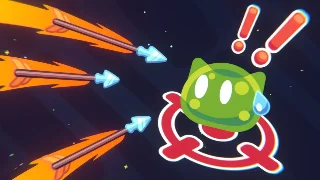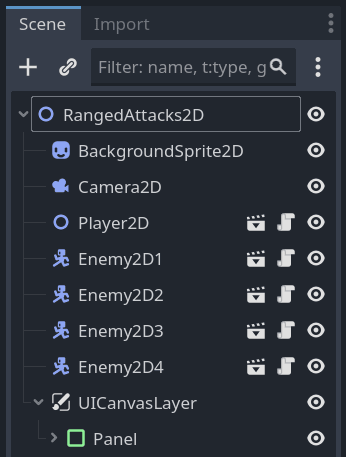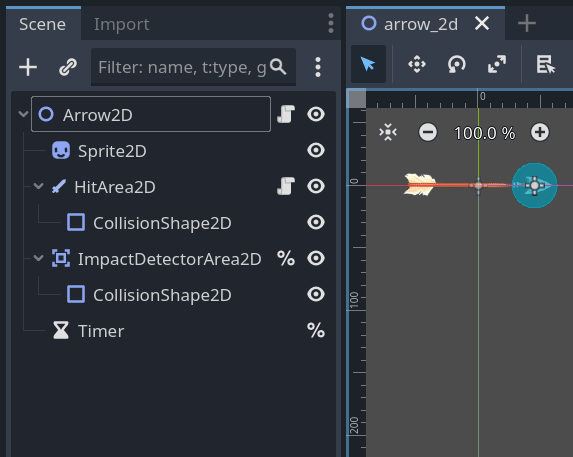2025/10/23

- Type
- Learning Resource
- Format
- Study Guide
- Version
- Godot 4.x
- Subject Tags
- Downloadable Demo
- FAQ/Troubleshooting
- Created
- Updated
- 2025/10/13
- 2025/10/23
In this guide, you'll learn how to create ranged attacks that shoot projectiles toward your mouse cursor in 2D games. We'll cover both single-target attacks like arrows or bullets and area of effect (AoE) attacks that damage multiple enemies at once.
In this study guide, you'll learn:
This section is a quick reference for the video above, which was made with Godot 3. Here's what changed in Godot 4 compared to the video:
onready var is now @onready var, and export var has become @export var.node.connect("signal_name", self, "callback_function"), we can now write node.signal_name.connect(callback_function) as signals and functions are first-class citizens.The rest of this guide uses Godot 4 syntax and conventions.
Head to the download section to download the open-source demo and explore the code.
In this demo, we're solving a common problem: how to make projectiles that damage enemies when you click to attack. Here are the key files you'll find in the demo:
Both projectiles move in a straight line toward where you clicked. The difference is in how they deal damage: the arrow damages the first enemy it touches, while the fireball spawns an area of effect explosion when it hits anything.

The enemies react to attacks with a hit animation to give you visual feedback.
The key code you'll learn from is in the projectile scripts, as that's where we handle movement, collision detection, and dealing damage. Let's first look at the arrow.
The arrow is our basic projectile that hits one enemy at a time. It flies toward your mouse position when you shoot. You'll see how to use this arrow as the base for the AoE fireball later.
Let's look at how it works.

We use two Area2D nodes to split up the work:
For the arrow, both collision shapes are the same size. Depending on the game and weapon, you'll need different sizes for these areas. You'll see that with the fireball down below.
The HitArea2D script sets up the collision layers and mask so enemies can detect it. It also stores the damage property that tells enemies how much health to lose when hit.
class_name HitArea2D
extends Area2D
@export var damage := 10
@onready var _collision_shape: CollisionShape2D = $CollisionShape2D
func _ready() -> void:
collision_layer = 2
collision_mask = 4
func set_disabled(is_disabled: bool) -> void:
_collision_shape.set_deferred("disabled", is_disabled)
This activates the physics layer 2 and masks layer 3. Collision layers and masks use binary values under the hood, so layer 2 is binary number 0010 and layer 3 is 0100. The bits with 1 mean "active" or "detect," while bits with 0 mean "inactive" or "ignore."
The collision layer is the physics layer we reserve for hit boxes in this demo, while the collision mask determines which layers this area can detect (hurt boxes in our case).
The set_disabled() function is called in the main projectile script to toggle the hit box on and off.
Before we move on to the fireball, here's how we coded the arrow_2d.gd script:
class_name Arrow2D
extends Node2D
@export var speed := 1000.0
@export var lifetime := 3.0
var direction := Vector2.ZERO
@onready var _impact_detector_area: Area2D = %ImpactDetectorArea2D
@onready var _timer: Timer = %Timer
func _ready():
_impact_detector_area.body_entered.connect(_on_impact_detector_area_body_entered)
_timer.timeout.connect(queue_free)
_timer.start(lifetime)
top_level = true
look_at(position + direction)
func _physics_process(delta: float) -> void:
position += direction * speed * delta
func _on_impact_detector_area_body_entered(_body: Node2D) -> void:
queue_free()
The speed property controls how fast the arrow moves in pixels per second, and lifetime is how long the arrow exists before disappearing.
In _ready(), we connect the impact detector to destroy the arrow when it hits something. We also start a timer that will automatically destroy the arrow after the lifetime ends, even if it hasn't hit anything yet.
The top_level property is important here. When set to true, it makes the arrow independent from its parent node. Without this, the arrow would rotate and move along with the player. We then use look_at() to rotate the arrow sprite to face the direction it's traveling. It moves in a straight line so we just need to point it in the right direction once.
The _physics_process() function moves the arrow every frame by updating its position based on the direction vector, speed, and delta time.
Finally, _on_impact_detector_area_body_entered() is called when the arrow collides with something. For the basic arrow, we destroy it with queue_free(). You can override this function in child classes to add different behaviors, like the explosion we'll see with the fireball.
Next let's look at the fireball script res://weapons/fireball_2d.gd. It extends this class and adds the area of effect explosion on top.
The first thing you'll notice in res://weapons/fireball_2d.tscn is that the two Area2D nodes have different collision shapes. We need HitArea2D to be much larger to cover the explosion radius and hit multiple enemies.
We start with HitArea2D disabled. If we left it enabled, the fireball would damage the first enemy it touches without exploding first. Instead, we use ImpactDetectorArea2D to detect when the fireball hits something and then trigger the explosion.
extends Arrow2D
@onready var _sprite: Sprite2D = %Sprite2D
@onready var _hit_area: Area2D = %HitArea2D
@onready var _explosion_particles: GPUParticles2D = %ExplosionGPUParticles2D
func _on_impact_detector_area_body_entered(_body: Node2D) -> void:
get_tree().create_timer(0.1).timeout.connect(
func _disable_hit_area():
_hit_area.set_disabled(true)
)
speed = 0.0
_sprite.visible = false
_explosion_particles.emitting = true
_hit_area.set_disabled(false)
_timer.start(0.6)
When the fireball hits something, we override the arrow's impact function to create an explosion. Here's what happens step by step.
First, we create a short timer that will disable the hit area after 0.1 seconds. During this brief window, any enemies within the explosion radius will get hit. We use a lambda function here to disable the hit area when the timer runs out.
Next, we stop the fireball from moving by setting its speed to zero. You could also call set_physics_process(false) to achieve the same result. Then we hide the fireball sprite and start the particle effect to show the explosion visually.
The important part is that we enable the hit area with set_disabled(false). We start with this area disabled in the scene. When we enable it, all enemies currently inside the radius will detect it and take damage.
Finally, the last line starts the timer to destroy the fireball after 0.6 seconds. It's to give enough time for the explosion effect to play before removing the node.
Import the zip file in Godot 4.5 or later to explore the code and see how everything works together. Feel free to modify the projectiles or create your own variants with different behaviors!
Don't stop here. Step-by-step tutorials are fun but they only take you so far.
Try one of our proven study programs to become an independent Gamedev truly capable of realizing the games you’ve always wanted to make.
Get help from peers and pros on GDQuest's Discord server!
20,000 membersJoin ServerThere are multiple ways you can join our effort to create free and open source gamedev resources that are accessible to everyone!
Sponsor this library by learning gamedev with us onGDSchool
Learn MoreImprove and build on assets or suggest edits onGithub
Contributeshare this page and talk about GDQUest onRedditYoutubeTwitter…